| Gulf of Corinth | |
|---|---|
| Κορινθιακός Κόλπος (Greek) | |
 Gulf of Corinth Gulf of Corinth | |
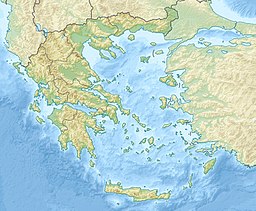 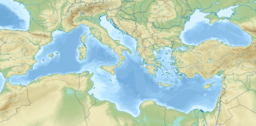 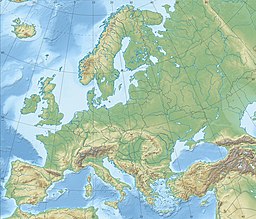 | |
| Coordinates | 38°12′N 22°30′E / 38.200°N 22.500°E / 38.200; 22.500 |
| Type | gulf |
| Part of | Ionian Sea (Mediterranean) |
| Basin countries | Greece |
| Max. length | 130 km (81 mi) |
| Max. width | 32 km (20 mi) |
| Min. width | 8.4 km (5.2 mi) |
| Surface area | 2,400 km (930 sq mi) |
| Max. depth | 935 m (3,068 ft) |
The Gulf of Corinth or the Corinthian Gulf (Greek: Κορινθιακός Κόλπος, romanized: Korinthiakós Kólpos, Greek pronunciation: [koɾinθiaˈkos ˈkolpos]) is a deep inlet of the Ionian Sea, separating the Peloponnese from western mainland Greece. It is bounded in the east by the Isthmus of Corinth which includes the shipping-designed Corinth Canal and in the west by the Rion Strait which widens into the shorter Gulf of Patras (part of the Ionian Sea) and of which the narrowest point is crossed since 2004 by the Rio–Antirrio bridge. The gulf is bordered by the large administrative divisions (regional units): Aetolia-Acarnania and Phocis in the north, Boeotia in the northeast, Attica in the east, Corinthia in the southeast and south and Achaea in the southwest. The tectonic movement across the gulf is comparable to parts of Iceland and Turkey, growing by 10 mm (0.39 in) per year.
In the Middle Ages, the gulf was known as the Gulf of Lepanto (the Italian form of Naupactus).
Shipping routes between the Greek commercial port Piraeus (further away from ultimate destinations but larger and better connected to the south than the north-western Greek port of Igoumenitsa) to western Mediterranean and hemisphere ports pass along this gulf. A ferry crosses the gulf to link Aigio and Agios Nikolaos, towards the western part of the gulf.
Geology
Main article: Gulf of Corinth basin
The gulf was created by the expansion of a tectonic rift due to the westward movement of the Anatolian Plate, and expands by 10 mm (0.39 in) per year. The surrounding faults can produce earthquakes up to magnitude around 6.5, though they are relatively uncommon. On June 15, 1995, an earthquake of magnitude 6.2 occurred near the city of Aigion. A large part of the northern margin of the gulf is characterized by gentle gradients (between 10 and 20 degrees). The southern margin of the gulf is largely characterized by steep gradients (between 30 and 40 degrees).
Nature

Cetaceans such as fin whales or dolphins are known to enter the Corinthian gulf occasionally.
Gulfs and bays
- Alkyonides Gulf, east
- Crissaean Gulf (Gulf of Crissa), north
- Bay of Antikyra, north
- Dombraina (Domvrena), north
- Rion Strait, links the Gulf to the Ionian Sea
Islands
- Trizonia (the only inhabited), Alkyonides Islands (group of islets), Ampelos (islet), Fonias (islet), Prasoudi (islet)
Bridges
Cities and towns
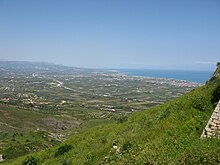
The main cities and towns that lie next to the gulf are, from the northwest clockwise, and grouped by regional unit:
- Aetolia-Acarnania: Antirrio, Nafpaktos
- Phocis: Galaxidi, Itea, Kirra
- Boeotia: Antikyra, Paralia Distomou
- West Attica
- Corinthia: Loutraki, Corinth, Assos, Vrachati, Velo, Kiato, Kato Diminio, Xylokastro
- Achaea: Aigeira, Diakopto, Aigio, Rododafni, Agios Vasileios, Aktaio
Tributaries
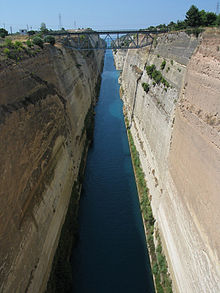
All tributaries are listed west to east.
Northern
Southern
- Selemnos
- Volinaios
- Foinikas
- Selinountas
- Vouraikos
- Krathis
- Krios
- Zacholitikos
- Fonissa
- Sythas
- Elissonas
- Asopos
References
- Thalassographica, Institute of Oceanographic and Fisheries Research, vol. 11–15, p. 35, (1988)
- "Greece's first electric ferry announced". Plugboats. 19 December 2019.
-
- Ambraseys, N. N.; Jackson, J. A. (1997). "Seismicity and strain in the Gulf of Corinth (Greece) since 1694". Journal of Earthquake Engineering. 1 (3): 433–474. Bibcode:1997JEaEn...1..433A. doi:10.1080/13632469708962374.
- Ambraseys, N. N. (May 2006). "Comparison of frequency of occurrence of earthquakes with slip rates from long-term seismicity data: the cases of Gulf of Corinth, Sea of Marmara and Dead Sea Fault Zone". Geophysical Journal International. 165 (2): 516–526. Bibcode:2006GeoJI.165..516A. doi:10.1111/j.1365-246X.2006.02858.x.
- Frostick, L. E.; Steel, R. J. (1994). "Tectonic Signatures in Sedimentary Basin Fills: An Overview". In L. E. Frostick; R. J. Steel (eds.). Tectonic Controls and Signatures in Sedimentary Successions. The International Association of Sedimentologists; Wiley. pp. 1–9. doi:10.1002/9781444304053.ch1. ISBN 9780632037452.
- "Fin Whale in the Gulf of Korinth". 19 May 2013. Posted by nefarius03. Archived from the original on 2021-12-21. Retrieved 13 April 2018 – via YouTube.
- "Trapped Whale in Greece" (video) Keep Talking Greece. 2011. Archived 2017-11-22 at the Wayback Machine. Retrieved November 6. 2014